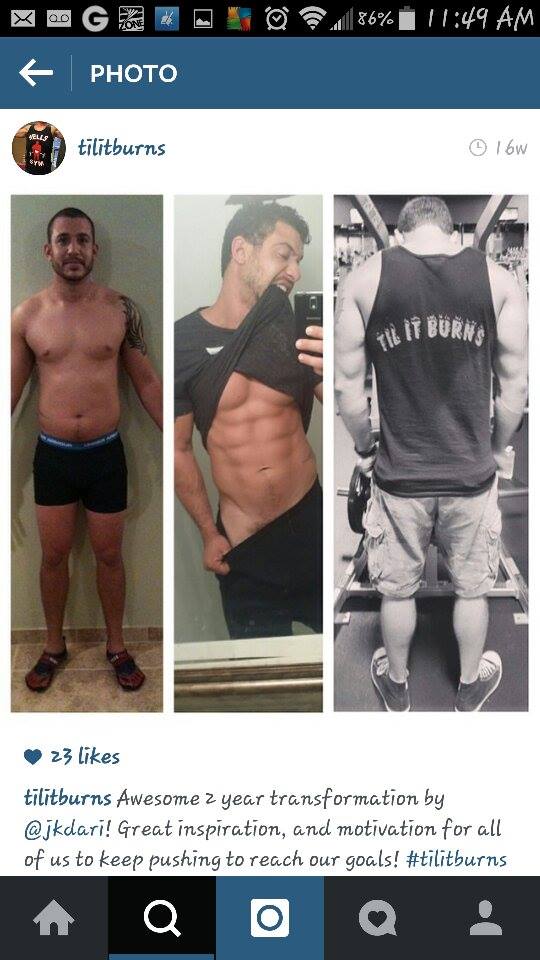Exploring the six-pack prize
By Nancy B. Loughlin
Published in News Press on January 20, 2015.
In the “before” shot, Fort Myers personal trainer Ari Garrido is Spongy Belly. In the “after” shot, two years later, he’s ripped.
It’s a great picture. He’s yanking down his shorts with one hand and hauling up his shirt with his teeth. Savage.
His washboard abs are making a statement. But what are they saying?
The Physical Core
Ripped abs have little to do with fitness. All that hammering for the washboard core is hurled against the rectus abdominis, a muscle that runs from the ribcage to the pelvis.
Physical fitness is the ability to perform tasks with ease, even those tasks that require more than the body’s normal effort. “Sexy beast” is not a fitness criterion.
So which of the five elements of fitness — cardiovascular, muscular strength, muscular endurance, flexibility and body composition – does a cut rectus have?
At best, a rippled visual core might meet the body composition element because a six pack is more dependent on low body fat than anything else. But even with low body fat and hundreds of crunches, there is no guarantee that the rectus is going to be on display because, genetically, it might not be in the cards.
“A visible six pack is not necessarily a bad thing if you want to aspire to it. But a shredded core has absurdly minimal fitness value,” said Victoria Haffer, wellness coach and trainer of yoga teachers and personal trainers.
For Haffer, the six pack quest reflects a misconception that a visible rectus abdominis is indicative of a strong core and lower back.
“The abs are core, but they aren’t true core,” Haffer said. She explained that a strong and stable true core involves the inner thighs, the pelvic floor muscles and the hip flexors. To strengthen this deep core means that you can live in balance at any time and moment in space.
“Look at dancers, gymnasts and surfers. They have true core strength. They don’t have to hold or stop movement to become stable. A strong deep core helps you to be more functional. You can wiggle around on one leg and not fall,” she said.
Another issue with pounding on the abs is that it overworks and overdevelops the front part of the body. This front body emphasis guarantees neglecting the opposing muscle groups in the back body resulting in imbalance and instability.
“People isolate muscles, and that is not how the body works. Everything is connected,” Haffer said. This is why it is so important to mix it up with cross training including yoga, dance, swimming and even rock wall climbing.
Granted, a six pack is sexy, so if you are fixated on getting one, at least do so in a balanced way, Haffer urges. In addition to working the rectus abdominis, tone and strengthen the erector spinae, the muscle columns that run parallel to the spine.
Come to hands and knees in tabletop position. On the inhale, lift your right arm straight in front of you and your left leg behind you parallel to the floor. Hold for three to five breaths. On an exhale, bring your elbow and knee to touch under the body. Hold for three to five breaths. Work your way up to 15 repetitions. Switch sides.
The Energetic Core
For yogis, the core is not about muscle. It’s about the energy of security, sexuality, creativity and personal power as represented by the first, second and third chakras.
“It’s the pranic hub of the body,” said Anna Withrow, owner of and teacher with Yoga Bird Studio, Fort Myers. “It’s the gateway for the spiritual development that can begin moving up the body.”
The abdomen is the seat of agni, that fire that digests more than food. It processes life. The lower chakra centers are imprinted with our earliest life experiences, and memory recall is often insufficient to access that energy.
It’s important to exercise the core to stoke that digestive fire, but it’s also important to “loosen the grip” that the lower energy has on our lives, Withrow said.
Unfortunately, due to a collective shame that’s centered in the belly, people don’t seem to be able to let it all hang out. People cross their arms over their power, suck it in or slouch. They are overly driven, self-critical, hungry all the time or burning out. So, they beat their bellies into submission with a fervor that borders on violence – crunch after crunch.
Instead, treat the belly in a nurturing way as it is a container for pranic energy. Build strength and release all that no longer serves you, and do it with focus and intention.
Begin by lying on your back with your legs bent, soles of the feet on the floor. On the exhale, isolate and lift the lowest muscles in the belly by squeezing your hip bones together. With just as much concentration, inhale, loosen the grip and lower.
Repeat the lower squeeze and then add the mid belly by bringing the hip bones toward the lower ribs. Release in reverse order slowly and deliberately. If you choose, add a third step by interlacing your hands behind your skull, keeping your head heavy. Lift the low belly, the mid belly and then lift the head off the floor during the exhale. Release with the inhale.
Learn more by visiting www.VictoriaHaffer.com and www.YogaBirdStudio.com.

